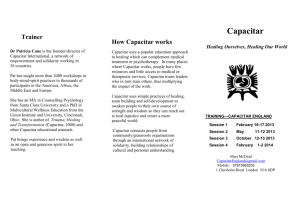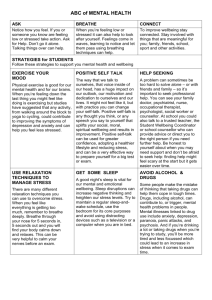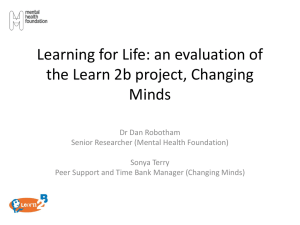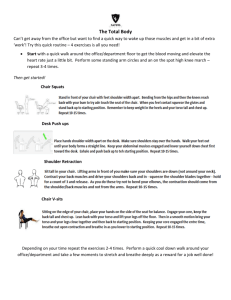CAPACITAR Emergency Response Tool Kit
advertisement
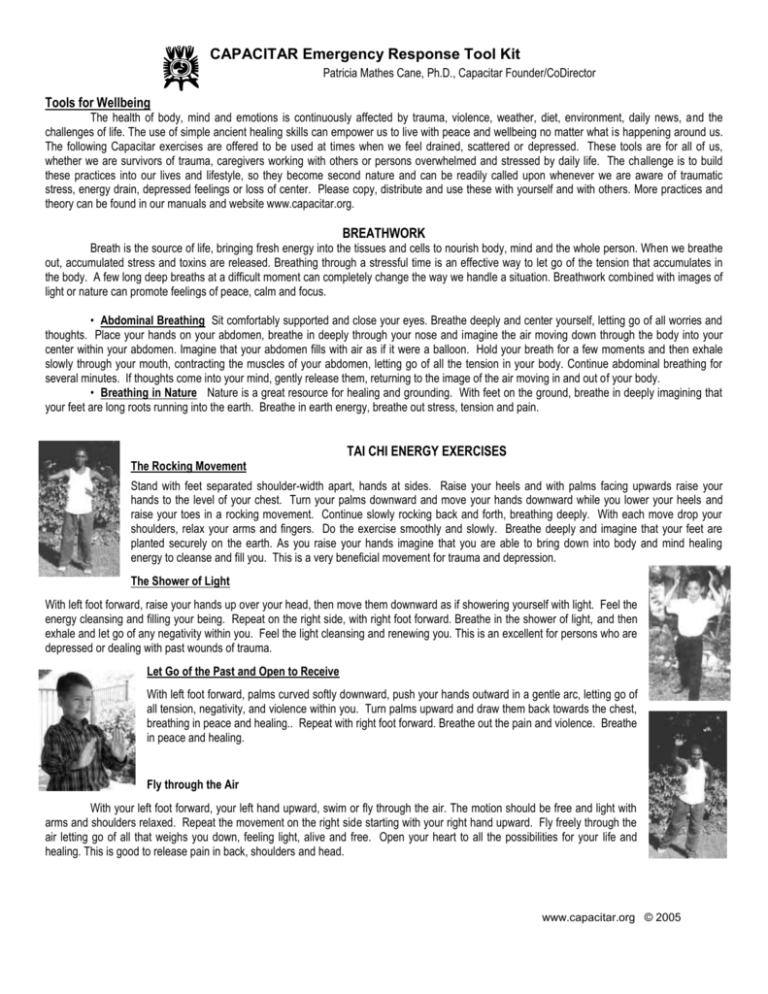
CAPACITAR Emergency Response Tool Kit Patricia Mathes Cane, Ph.D., Capacitar Founder/CoDirector Tools for Wellbeing The health of body, mind and emotions is continuously affected by trauma, violence, weather, diet, environment, daily news, and the challenges of life. The use of simple ancient healing skills can empower us to live with peace and wellbeing no matter what is happening around us. The following Capacitar exercises are offered to be used at times when we feel drained, scattered or depressed. These tools are for all of us, whether we are survivors of trauma, caregivers working with others or persons overwhelmed and stressed by daily life. The challenge is to build these practices into our lives and lifestyle, so they become second nature and can be readily called upon whenever we are aware of traumatic stress, energy drain, depressed feelings or loss of center. Please copy, distribute and use these with yourself and with others. More practices and theory can be found in our manuals and website www.capacitar.org. BREATHWORK Breath is the source of life, bringing fresh energy into the tissues and cells to nourish body, mind and the whole person. When we breathe out, accumulated stress and toxins are released. Breathing through a stressful time is an effective way to let go of the tension that accumulates in the body. A few long deep breaths at a difficult moment can completely change the way we handle a situation. Breathwork combined with images of light or nature can promote feelings of peace, calm and focus. • Abdominal Breathing Sit comfortably supported and close your eyes. Breathe deeply and center yourself, letting go of all worries and thoughts. Place your hands on your abdomen, breathe in deeply through your nose and imagine the air moving down through the body into your center within your abdomen. Imagine that your abdomen fills with air as if it were a balloon. Hold your breath for a few moments and then exhale slowly through your mouth, contracting the muscles of your abdomen, letting go of all the tension in your body. Continue abdominal breathing for several minutes. If thoughts come into your mind, gently release them, returning to the image of the air moving in and out of your body. • Breathing in Nature Nature is a great resource for healing and grounding. With feet on the ground, breathe in deeply imagining that your feet are long roots running into the earth. Breathe in earth energy, breathe out stress, tension and pain. The Rocking Movement TAI CHI ENERGY EXERCISES Stand with feet separated shoulder-width apart, hands at sides. Raise your heels and with palms facing upwards raise your hands to the level of your chest. Turn your palms downward and move your hands downward while you lower your heels and raise your toes in a rocking movement. Continue slowly rocking back and forth, breathing deeply. With each move drop your shoulders, relax your arms and fingers. Do the exercise smoothly and slowly. Breathe deeply and imagine that your feet are planted securely on the earth. As you raise your hands imagine that you are able to bring down into body and mind healing energy to cleanse and fill you. This is a very beneficial movement for trauma and depression. The Shower of Light With left foot forward, raise your hands up over your head, then move them downward as if showering yourself with light. Feel the energy cleansing and filling your being. Repeat on the right side, with right foot forward. Breathe in the shower of light, and then exhale and let go of any negativity within you. Feel the light cleansing and renewing you. This is an excellent for persons who are depressed or dealing with past wounds of trauma. Let Go of the Past and Open to Receive With left foot forward, palms curved softly downward, push your hands outward in a gentle arc, letting go of all tension, negativity, and violence within you. Turn palms upward and draw them back towards the chest, breathing in peace and healing.. Repeat with right foot forward. Breathe out the pain and violence. Breathe in peace and healing. Fly through the Air With your left foot forward, your left hand upward, swim or fly through the air. The motion should be free and light with arms and shoulders relaxed. Repeat the movement on the right side starting with your right hand upward. Fly freely through the air letting go of all that weighs you down, feeling light, alive and free. Open your heart to all the possibilities for your life and healing. This is good to release pain in back, shoulders and head. www.capacitar.org © 2005 FINGERHOLDS TO MANAGE EMOTIONS The following practice is a simple way to work with emotions by holding each finger. Emotions and feelings are like waves of energy moving through the body and mind. Through each finger runs a channel or meridian of energy connected with an organ system and related emotions. With strong or overwhelming feelings, energy can become blocked or repressed, resulting in pain or congestion in the body. Holding each finger while breathing deeply can bring emotional and physical release and healing. The fingerholds are a very helpful tool to use in daily life. In difficult or challenging situations when tears, anger or anxiety arise, the fingers may be held to bring peace, focus and calm so that the appropriate response or action may be taken. The practice may also be done for relaxation with music, or used before going to sleep to release the problems of the day and to bring deep peace to body and mind. The practice may be done on oneself or on another person. FINGERHOLD PRACTICE: Hold each finger with the opposite hand 2-5 minutes. You can work with either hand. Breathe in deeply; recognize and acknowledge the strong or disturbing feelings or emotions you hold inside yourself. Breathe out slowly and let go. Imagine the feelings draining out your finger into the earth. Breathe in a sense of harmony, strength and healing. And breathe out slowly, releasing past feelings and problems. Often as you hold each finger, you can feel a pulsing sensation as the energy and feelings move and become balanced. You can hold the fingers of someone else who is angry or upset. The fingerholds are very helpful for young children who are crying or having a tantrum, or can be used with people who are very fearful, anxious, sick or dying. ANGER, RAGE, RESENTMENT FEAR, PANIC WORRY, ANXIETY PREOCCUPATION LACK OF SELF ESTEEM TEARS, GRIEF, EMOTIONAL PAIN www.capacitar.org © 2005 EMOTIONAL FREEDOM TECHNIQUE—EFT The Emotional Freedom Technique (EFT) developed by Gary Craig, Ph.D., is very useful for unblocking and healing strong emotions, fears, anxiety, emotional pain, anger, traumatic memories, phobias and addictions, as well as for alleviating body symptoms and pain, such as headaches and overall body pain. The technique is based on the theory of the energy field of body, mind and emotions, along with meridian theory of Eastern medicine. Problems, traumas, anxiety and pain can cause a block in the energy flow of the body. Tapping or pressing acupressure points connected with channels or meridians of energy can help move blocked energy in congested areas and promote the healthy flow of energy in the body and in mental and emotional fields. (Adapted with permission from the EFT materials of Gary Flint, Ph.D. Emotional Freedom Technique.) EFT Practice: 1.Think of an issue to work with and measure your anxiety level: Choose to work with a problem, worry, phobia, anxiety, traumatic memory or negative self-concept. Using a scale of 0—10, measure the level of anxiety that you feel when thinking about the issue. (0 means no anxiety, 10 means extremely high level of anxiety). If it is difficult to quantify or measure with a number, use a simple scale such as: (none, small, medium, large) or (big to little) or (tall to short). 2. Tap the sequence of Acupressure Points 7-9 times: Breathe deeply and tap 7 to 9 times with index & middle fingers : • Points above where the eyebrows begin 1 • Points at the side of the eyebrows 2 • Points below the pupils of eyes on bone 3 • Point below the nose 4 • Point below the lips on the chin 5 • Points below armpits (about 4 inches down) 6 • Points below clavicles on sides of sternum 7 3. Tap point A at side of hand and say: Tap the Polarity Reversal Point A at the side of the hand while saying 3 times: “In spite of the fact I have this problem, I’m OK, I accept myself.” (Wording may be adapted for culture or age of person.) 4. Repeat the sequence in #2 & #3 Repeat sequence until anxiety level is down to 0-2. 5. Rub the Sore Spot B: Rub or press the Sore Spot located on the left side of the chest about 3 inches below the left collar bone and 2-3 inches to the side of the sternum. www.capacitar.org © 2005 THE HOLDS This practice consists of several simple energy holds that may be done on oneself or on another person for anxiety, emotional or physical pain, traumatic memories, strong emotions, such as anger or fear, insomnia and for deep relaxation. Through the energy of our hands we have the power to bring profound peace, harmony and healing to body, mind and emotions. As the practice is used on oneself or on another, hold in mind and heart a deep sense of peace, light and spaciousness. The holds can be done for several minutes each, accompanied by deep abdominal breathing to promote greater release. The touch is very light, and if someone fears touch because of pain or their history of abuse, the holds may be done off the body working in the energy field. Always ask permission when you do any practice involving touch of another person. Halo Hold Head Hold One hand lightly holds the head high on the forehead; the other hand holds the base of the skull. The energy of the hands connects with parts of the brain related to memories and emotions. Crown Hold Thumbs of both hands together contact crown center at the top of head. Fingertips softly touch area across the forehead. Along with deep breathing this hold is used in different bodywork modalities to promote emotional release. Shoulder Hold The hands rest lightly on the shoulders, the place in the body related to anxiety, excess baggage or the burdens of life. Heart Hold One hand rests across sternum high on chest. The other hand touches upper back behind the heart. The heart area often holds emotional pain, wounds of the past, grief and resentment. Breathe deeply and imagine the heart pain draining down into the earth. You can also do this hold several inches off the body respectful of the person’s boundaries. To finish, Lightly brush off the energy field with the hands. The tops of the feet may also be held to ground the person. www.capacitar.org © 2005 HEAD NECK SHOULDER RELEASE This acupressure practice releases pain, tension and congestion in the upper back, shoulders, neck and head. Often with trauma and stress, energy becomes blocked in shoulders, neck and head. Most of the energy channels or meridians flow through this area, resulting in a “bottle neck” of tension in some people. This practice can easily be done on oneself, or on another person, either seated or lying comfortably face-up. This is a very good practice for anxiety at night or when one is unable to sleep. If doing this with another person, be sure that you keep clear boundaries, and if you feel their energy coming into your hands, imagine that it can flow through and down into the earth. With slightly curved fingertips, press into each of the sets of points (1-6) for 1 to 2 minutes, or until the energy pulse is clear, strong and flowing. The points will usually be very sensitive. During the practice you can imagine energy flowing upward and out the top of the head while breathing deeply. To end the practice imagine that your feet are rooted to the earth to ground you. If working on another, you can hold the tops of their feet for a few moments to ground them. (Adapted from the work of Aminah Raheem and Iona Teegarden.) Sets of Points: 1. About an inch outside the bottom of the shoulder joint where the arm connects to the trunk of the body. 2. At the top of the inside curve of shoulder blades about 2 inches from the center of the spine. 3. On top of the shoulders at the base of the neck in the trapezious muscle. 4. Midway up the neck in the band of muscles on either side of the spine. 5. In the hollows at the base of the skull at the sides of the head. 6. The crown center at the top of the head. To Finish: Hold the tops of the feet for grounding or if done on onself, imagine that the feet are rooted in the ground. Breathe deeply and feel peace and harmony in body, mind and emotions. www.capacitar.org © 2005 ACUPRESSURE FOR PAIN AND TRAUMATIC STRESS Depression These acupressure points are for depression and emotional heaviness to bring a sense of peace and wellbeing. Crown of head Hold lightly the top of the head. There are three acupressure points in a line in this area. Forehead between the Eyebrows With the fingertips of one hand hold the sensitive area between the eyebrows where the nose connects with the forehead. Base of Skull at the Sides of the Head Interlace fingers, place your hands behind your head, and with the thumbs press the two points at left and right sides of the base of the skull in the indentation between the muscles and bones. Anxiety, Crisis & Overwhelm Point in the Outer Wrist Press point in the indentation on the outside of the crease of the wrist, down from the small finger. Point on Top of the Shoulders With the fingertips of both hand hold the points on top of the shoulders. The arms may be crossed if this position is more comfortable. Sore Spot Locate a spore spot in the left side of the chest about 2-3 inches down from the collar bone and about 2 inches to the side of the sternum. Fainting, Crisis & High Blood Pressure This point can be used on oneself or another if a person is fainting or in crisis. Point Beneath the Nose With index fingertip or knuckle of the finger, press into the point directly below the nose on the upper lip. Insomnia Point in Forehead with Point in Center of Chest Hold at the same time the point in the middle of the forehead and the point in the middle of the chest. www.capacitar.org © 2005 TRAUMA AND THE INSTINCT TO HEAL There are many new methods being developed to treat depression, anxiety and traumatic stress. Medical professionals studying the impact of trauma on the body, now recognize that the human brain is composed of a "cognitive" brain responsible for language and abstract thinking, and a "limbic or emotional" brain responsible for emotions and the instinctual control of behavior. The emotional brain controls much of the body's physiology, autonomic responses and psychological wellbeing. Cognitive psychotherapy and medication are the usual methods used for stabilizing and treating traumatized persons, but in many cases this approach is not enough, nor is it appropriate in many cultures. In his book The Instinct to Heal, psychiatrist David Servan-Schreiber, M.D. (2004), says that "emotional disorders result from dysfunctions in the emotional brain. . .The primary task of treatment is to 'reprogram' the emotional brain so that it adapts to the present instead of continuing to react to past experiences... It is generally more effective to use methods that act via the body and directly influence the emotional brain rather than use approaches that depend entirely on language and reason, to which the emotional brain is not receptive. The emotional brain contains natural mechanisms for self-healing: 'an instinct to heal'." This instinct to heal is the natural ability to find balance and wellbeing in body, mind and emotions. Capacitar: A Popular Education Approach to Trauma Healing In working with the traumatized, Capacitar's methods involve awakening and empowering this "instinct to heal". Because the experience of grassroots trauma is so vast, Capacitar uses a popular education approach rather than an individual therapeutic approach, placing in people's hands simple body-based skills they can use for themselves to release stress, manage emotions and live with balance in the midst of the challenges of life. A key to this approach is the inherent "instinct" or wisdom in the organism to return to balance and wholeness. Healing occurs through the release of undischarged energy as well as through a strengthening of the natural flow of energy. With the renewed flow of energy the person returns to a state of balance and wellbeing. Living in Wellness Living with wellbeing is a very different experience of health than stabilizing symptoms or curing mental or physical disease. In contrast to a scientific worldview of health that involves “fixing or curing", wellness in Eastern and indigenous models is based on wholeness and harmony in the energy or life force of body, mind and emotions. When energy is flowing freely and without obstruction through the channels and energy centers of the body, the person experiences good health, emotional balance, mental clarity, and overall wellbeing. The practices offered in this Capacitar Emergency Tool Kit help to awaken this state of wellbeing, providing tools for the healing of past wounds and for the recuperation of inner strength and energy in the person. The practices have been used with many thousands of people in 26 countries and many different cultures. They have been found to be helpful for persons with traumatic stress, as well as for self care for those working with others. These practices are meant to be used as part of daily life to help rebalance depleted, congested or excessive energy, as well as to nourish and build core energy. Regular use of practices such as Tai Chi, acupressure, and breathwork help to alleviate traumatic stress symptoms manifesting as headaches, body pain, stomach disorders, diarrhea, insomnia, anxiety, and chronic fatigue. But it is not enough to only alleviate physical or emotional symptoms. Healing involves a deeper change in the whole system—from the person, their relationships, and their environment, down to cellular and energetic levels. The way traumatic experience is handled can be a catalyst for growth and transformation. Past wounds can be transformed into wisdom to live more fully. There is a return to balance and wholeness, the natural state of the person and the community. As individuals heal they in turn are able to reach out to their family, community and the larger world to bring health and wholeness to the human family. For other resources, manuals and CDs of practices, see our Capacitar website: www.capacitar.org. We join with the earth and with each other With our ancestors and all beings of the future To bring new life to the land To recreate the human community To provide justice and peace To remember our children To remember who we are. We join together as many and diverse expressions Of community and empowerment, For the healing of the earth and the renewal of all life. www.capacitar.org © 2005 —Capacitar Philosophy based on writings of the UN
